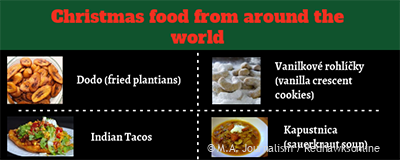Christmas food meets global traditions
It is almost Christmas time. Everyone is shopping for gifts, but what people don’t do, is ask what their friends do to celebrate Christmas. Some people at Minnehaha have very unique Christmas traditions and guess what, they might be sitting right next to you in history class.
Because Christianity has spread throughout the world, Christmas is celebrated in many culturally diverse ways. Sometimes it is easy to get caught up with sticking to the things that you do and know, but getting to learn about other people’s cultures can make a big impact on your life.
KarolÃna ÄŒižmárova & Patrik PavlÃk: Slovakia
Flying over the Atlantic Ocean to the heart of Europe, in Slovakia, on December 5 families put their boots near a window or a door and leave it overnight. It is like hanging stockings in America.
On the morning of Dec. 6, “we get either sweets and fruit if you’re nice or good or you get charcoal and garlic…if you are naughty,” said Karolina CÞmárová, a junior exchange student from Bratislava.
This tradition is called Mikuláš. Most people have a Christmas carp for Christmas Eve dinner.
“We keep the fish…in the bathtub for three days,” she said, “and then we kill it and we eat it.”
This is a very common tradition among eastern Europeans, not just Slovak people.
In another Christmas tradition, Slovaks use their fingers to make a cross on their immediate family members’ forehead. This is done to ensure goodness and prosperity for the people. They also reflect on the year and think about what is coming up.
Some traditions are done especially for kids. “We cut an apple in half and look for a star in the middle,” said CÞmárová. If they find a star in the middle, it brings good luck for the next year.
CÞmárová said that her favorite Christmas tradition is opening presents on Christmas Eve when JežÃÅ¡ko (Baby Jesus) brings gifts.
In Slovakia, there are many traditional foods. For example, there is a sour cabbage (sauerkraut) soup called Kapustnica. It has sausage, cabbage, and mushrooms. A dessert that is common is vianoÄné oblátky, a Christmas wafer which can have honey, whipped cream and walnuts.
Rolyns & Prince Aligbe: Nigeria
For Nigerian Christians, Christmas is focused around family and the church.
“We spend our Christmas Eve at church throughout the whole entire night from 10 till 2 in the morning,” said sophomore Prince Aligbe. “But during that whole time we…talk about how Christmas is going to be spent with our families.”
Another part of a Nigerian Christmas is the food. In Aligbe’s family, they eat American food, like mac and cheese and chicken, but they also eat traditional Nigerian jollof rice, dodo (fried plantains) and a greens soup mix.
“Reminiscing on good times and remembering other people that [were] here last time but couldn’t be here now…we pray for them,” Aligbe said.
He describes the time together as an important part of Christmas.
“My favorite thing probably would just be spending time with family,” he said. “The best thing is probably spending time with family that you wouldn’t see every single day.”
Grace & Sita Baker: Indigenous Minnesota
In Sita and Grace Baker’s indigenous Minnesota family – combining Dakota (Prairie Island), Lakota (Cheyenne River) and Ojibwe (Red Lake) heritage -while Christmas doesn’t include any native pow-wow celebrations, one thing that they do is make spirit plate.
“You put all the food that you make, a little bit of each, into a bowl, and you pray with it,” said Grace, a sophomore. “You put tobacco in it, and you put it outside.”
The spirit plate is put together for loved ones and spirits. Some of the foods that are made include Indian tacos (tacos with fry bread as the tortilla) and wild rice. The Baker family opens Christmas presents on Christmas Eve.

